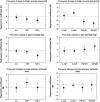Higher inflammatory marker levels in older persons: associations with 5-year change in muscle mass and muscle strength
- PMID: 19622801
- PMCID: PMC2759573
- DOI: 10.1093/gerona/glp097
Higher inflammatory marker levels in older persons: associations with 5-year change in muscle mass and muscle strength
Abstract
Background: There is growing evidence that higher levels of inflammatory markers are associated with physical decline in older persons, possibly through the catabolic effects of inflammatory markers on muscle. The aim of this study was to investigate the association between serum levels of inflammatory markers and loss of muscle mass and strength in older persons.
Methods: Using data on 2,177 men and women in the Health, Aging, and Body Composition Study, we examined 5-year change in thigh muscle area estimated by computed tomography and grip and knee extensor strength in relation to serum levels of interleukin-6 (IL-6), C-reactive protein, tumor necrosis factor-alpha (TNF-alpha), and soluble receptors (measured in a subsample) at baseline.
Results: Higher levels of inflammatory markers were generally associated with greater 5-year decline in thigh muscle area. Most associations, with the exception of soluble receptors, were attenuated by adjustment for 5-year change in weight. Higher TNF-alpha and interleukin-6 soluble receptor levels remained associated with greater decline in grip strength in men. Analyses in a subgroup of weight-stable persons showed that higher levels of TNF-alpha and its soluble receptors were associated with 5-year decline in thigh muscle area and that higher levels of TNF-alpha were associated with decline in grip strength.
Conclusions: TNF-alpha and its soluble receptors showed the most consistent associations with decline in muscle mass and strength. The results suggest a weight-associated pathway for inflammation in sarcopenia.
Figures

Similar articles
-
Relationship of interleukin-6 and tumor necrosis factor-alpha with muscle mass and muscle strength in elderly men and women: the Health ABC Study.J Gerontol A Biol Sci Med Sci. 2002 May;57(5):M326-32. doi: 10.1093/gerona/57.5.m326. J Gerontol A Biol Sci Med Sci. 2002. PMID: 11983728
-
Inflammatory markers and loss of muscle mass (sarcopenia) and strength.Am J Med. 2006 Jun;119(6):526.e9-17. doi: 10.1016/j.amjmed.2005.10.049. Am J Med. 2006. PMID: 16750969
-
The relationship between grip strength and muscle mass (MM), inflammatory biomarkers and physical performance in community-dwelling very old persons.Arch Gerontol Geriatr. 2013 Nov-Dec;57(3):345-51. doi: 10.1016/j.archger.2013.06.003. Epub 2013 Jul 4. Arch Gerontol Geriatr. 2013. PMID: 23830056
-
Effect of resistance training on inflammatory markers of older adults: A meta-analysis.Exp Gerontol. 2018 Oct 1;111:188-196. doi: 10.1016/j.exger.2018.07.021. Epub 2018 Jul 30. Exp Gerontol. 2018. PMID: 30071283 Review.
-
Markers of inflammation and their association with muscle strength and mass: A systematic review and meta-analysis.Ageing Res Rev. 2020 Dec;64:101185. doi: 10.1016/j.arr.2020.101185. Epub 2020 Sep 26. Ageing Res Rev. 2020. PMID: 32992047
Cited by
-
What is dynapenia?Nutrition. 2012 May;28(5):495-503. doi: 10.1016/j.nut.2011.12.002. Nutrition. 2012. PMID: 22469110 Free PMC article. Review.
-
Sarcopenia and cachexia: the adaptations of negative regulators of skeletal muscle mass.J Cachexia Sarcopenia Muscle. 2012 Jun;3(2):77-94. doi: 10.1007/s13539-011-0052-4. Epub 2012 Jan 12. J Cachexia Sarcopenia Muscle. 2012. PMID: 22476916 Free PMC article.
-
Nutrition Mediates the Relationship between Osteosarcopenia and Frailty: A Pathway Analysis.Nutrients. 2020 Sep 27;12(10):2957. doi: 10.3390/nu12102957. Nutrients. 2020. PMID: 32992541 Free PMC article.
-
Regrowth after skeletal muscle atrophy is impaired in aged rats, despite similar responses in signaling pathways.Exp Gerontol. 2015 Apr;64:17-32. doi: 10.1016/j.exger.2015.02.007. Epub 2015 Feb 12. Exp Gerontol. 2015. PMID: 25681639 Free PMC article.
-
Serum Uric Acid Is Positively Associated with Handgrip Strength among Japanese Community-Dwelling Elderly Women.PLoS One. 2016 Apr 14;11(4):e0151044. doi: 10.1371/journal.pone.0151044. eCollection 2016. PLoS One. 2016. PMID: 27078883 Free PMC article.
References
-
- Alexandraki K, Piperi C, Kalofoutis C, Singh J, Alaveras A, Kalofoutis A. Inflammatory process in type 2 diabetes: the role of cytokines. Ann N Y Acad Sci. 2006;1084:89–117. - PubMed
-
- Blake GJ, Ridker PM. Novel clinical markers of vascular wall inflammation. Circ Res. 2001;89(9):763–771. - PubMed
-
- Erren M, Reinecke H, Junker R, et al. Systemic inflammatory parameters in patients with atherosclerosis of the coronary and peripheral arteries. Arterioscler Thromb Vasc Biol. 1999;19(10):2355–2363. - PubMed
-
- Vasan RS, Sullivan LM, Roubenoff R, et al. Inflammatory markers and risk of heart failure in elderly subjects without prior myocardial infarction: the Framingham Heart Study. Circulation. 2003;107(11):1486–1491. - PubMed
Publication types
MeSH terms
Substances
Grants and funding
LinkOut - more resources
Full Text Sources
Other Literature Sources
Research Materials

